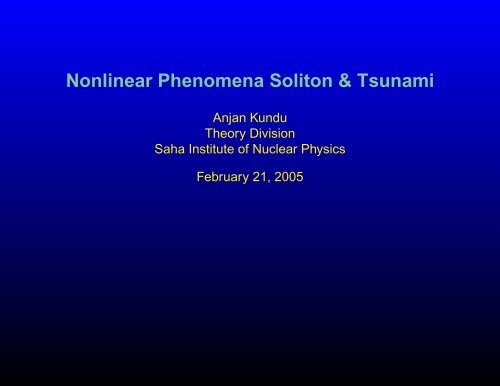Nonlinear Phenomena Soliton & Tsunami - Saha Institute of Nuclear ...
Nonlinear Phenomena Soliton & Tsunami - Saha Institute of Nuclear ...
Nonlinear Phenomena Soliton & Tsunami - Saha Institute of Nuclear ...
Create successful ePaper yourself
Turn your PDF publications into a flip-book with our unique Google optimized e-Paper software.
<strong>Nonlinear</strong> <strong>Phenomena</strong> <strong>Soliton</strong> & <strong>Tsunami</strong><br />
Anjan Kundu<br />
Theory Division<br />
<strong>Saha</strong> <strong>Institute</strong> <strong>of</strong> <strong>Nuclear</strong> Physics<br />
February 21, 2005
NONLINEAR PHENOMENA SOLITON & TSUNAMI 1<br />
Traditional <strong>Tsunami</strong> Theory<br />
• A plane wave <strong>of</strong> long wave length<br />
Evolution Equation for water elevation U (x,t) (x → - direction from sea to<br />
shore):<br />
1<br />
v 2U(x, t) tt = U(x, t) xx ,<br />
∂U<br />
∂x ≡ U x, velocity v = √ gH<br />
• Near shore <strong>Tsunami</strong> effects : i) H ↓↓ v, (slowing down <strong>of</strong> waves)<br />
ii) due to conservation <strong>of</strong> energy Amplitude A ↑ (increase in amplitude)<br />
➥ Therefore everything seems to be well-described<br />
IS IT REALLY !<br />
Few Questions about <strong>Tsunami</strong>05 <br />
➥ <strong>Tsunami</strong> traveled: from epicenter <strong>of</strong> (Near Banda Aceh, Northern Sumatra,<br />
Indonesia): −→ to Port Elizabeth, South Africa<br />
8000 km distance!<br />
• How can a linear plane wave travel such a long distance without<br />
dispersion ➥Not a single but a group <strong>of</strong> waves hit the shores.
NONLINEAR PHENOMENA SOLITON & TSUNAMI 2<br />
• The individual waves have different intensities. Why <br />
• At Banda Aceh the 2nd wave was the most intense, while at<br />
Nagapattanam it was the 1st one:<br />
Why switching <strong>of</strong> intensities <br />
• At Banda Aceh the interval between the 1st & 2nd waves was 10 min.,<br />
while at Nagapattanam it was 40 min.:<br />
How wave-length can change <br />
Can the traditional linear wave theory Answer them<br />
Possibly, NO !!!<br />
So, we have to look for some other explanation.<br />
⋄ Let us make together a time travel <strong>of</strong> 30 years near the same spot.<br />
Andaman Sea: October 1976<br />
Northern Sumatra Indonesia !! ( Science, 1980, vol 208, 451 , (by A. R.<br />
Osborn ( Research Physicist at Exon Prod. research Com., Texas) & T Burch<br />
Oceanographer, Massachusets)
NONLINEAR PHENOMENA SOLITON & TSUNAMI 3<br />
Appolo-Soyuz Space-Photo
NONLINEAR PHENOMENA SOLITON & TSUNAMI 4<br />
Experiment in the open sea : Internal waves
NONLINEAR PHENOMENA SOLITON & TSUNAMI 5<br />
Experimental data on single <strong>Soliton</strong>
NONLINEAR PHENOMENA SOLITON & TSUNAMI 6<br />
Single <strong>Soliton</strong>!
NONLINEAR PHENOMENA SOLITON & TSUNAMI 7<br />
To Understand this let us make a space-time-travel →<br />
August 1834: A canal near Edinburg, UK<br />
Where a British Naval Engineer was riding on a horse back.
NONLINEAR PHENOMENA SOLITON & TSUNAMI 8<br />
John Scott Russel :<br />
(British Naval Engineer)
NONLINEAR PHENOMENA SOLITON & TSUNAMI 9<br />
”I was observing the motion <strong>of</strong> a boat which was rapidly drawn along by<br />
a pair <strong>of</strong> horses, when the boat suddenly stopped-not so the mass <strong>of</strong><br />
water... it accumulated round the prow <strong>of</strong> the vessel in a state <strong>of</strong> violent<br />
agitation.<br />
Then suddenly ...rolled forward with a great velocity, assuming the form <strong>of</strong> a<br />
large solitary elevation, a rounded, smooth and well-defined heap <strong>of</strong> water.,<br />
which continued its course along the channel apparently without change <strong>of</strong><br />
form and or diminution <strong>of</strong> speed.<br />
I followed it on horse-back...thirty feet long and a foot to a foot and a half in<br />
height..and after a chase <strong>of</strong> 1 or 2 miles I lost it.<br />
Such in the month <strong>of</strong> August 1934 was my first chance interview with that<br />
singular and beautiful phenomenon”
NONLINEAR PHENOMENA SOLITON & TSUNAMI 10<br />
Mathematical formulation <strong>of</strong> this Nonlnear <strong>Phenomena</strong> came in 1895:<br />
Korteveg & de Vries (KdV)<br />
(Derived from Navier-Stokes eqn)
NONLINEAR PHENOMENA SOLITON & TSUNAMI 10<br />
Mathematical formulation <strong>of</strong> this Nonlnear <strong>Phenomena</strong> came in 1895:<br />
Korteveg & de Vries (KdV)<br />
(Derived from Navier-Stokes eqn)<br />
∂u<br />
∂t = ∂3 u<br />
∂x + u∂u<br />
3 ∂x<br />
Where the the ’repulsive’ dispersive term finely balances the ’attractive’<br />
nonlinear interaction term. Hence emerges<br />
☞ Stable localised solution<br />
☞ Preserves its shape and velocity during collition with other such objects!!<br />
(Behaves like ’particles’ under interaction)<br />
☞ This nonlinear nonperturbative exact slution is called <strong>Soliton</strong>
NONLINEAR PHENOMENA SOLITON & TSUNAMI 11<br />
Further advancement:<br />
<strong>Nonlinear</strong> Integrable Systems<br />
☞ Allow exact nonperturbative solutions<br />
☞ Infinite number <strong>of</strong> conserved quantities<br />
☞ Apart from the KdV many other nonlinear equations belong to this class<br />
☞ Theory was laid by stalwarts like Liouville, Poincaré, Painleveé and<br />
Kovalewskaya
NONLINEAR PHENOMENA SOLITON & TSUNAMI 12<br />
Sophia Kovalewskaya :<br />
(Russian Mathematician)
NONLINEAR PHENOMENA SOLITON & TSUNAMI 13<br />
Triumph <strong>of</strong> Integrable Systems<br />
Over the years it was understood that our world is interacting & hence<br />
<strong>Nonlinear</strong><br />
☞ Many natural phenomena are described by it:<br />
starting from ocean waves to atmospheric vortices,<br />
from nerve signal propagation to plasma soliton,<br />
from cosmic objects to knot theory
NONLINEAR PHENOMENA SOLITON & TSUNAMI 14<br />
Knots & Links possess <strong>Soliton</strong>ic features
NONLINEAR PHENOMENA SOLITON & TSUNAMI 15<br />
Universality <strong>of</strong> <strong>Nonlinear</strong> Integrable System<br />
Apart from KdV a host <strong>of</strong> other systems found to show the same featires:<br />
Integrability & <strong>Soliton</strong> solution<br />
•Modified KdV<br />
u t = u xxx + u 2 u x , u = u(x, t), u t ≡ ∂u<br />
∂t<br />
• <strong>Nonlinear</strong> Schrödinger equation (NLS)<br />
• Sine-Gordon equation<br />
• Liouville equation<br />
iψ t = ψ xx + 2(ψ † ψ)ψ = 0, ψ = ψ(x, t)<br />
u tt − u xx = m 2 sin u, u ≡ u(x, t)<br />
u tt − u xx = e ηu u ≡ u(x, t) etc.
NONLINEAR PHENOMENA SOLITON & TSUNAMI 16<br />
☞ All these models share common properties & solved using Inverse<br />
Scattering method<br />
People involved:Kruskal-Zabuztki-Ablowitz-Zakharov-Novikov (1960-’85),<br />
etc. Next breakthrough: Quantum Integrable Systems<br />
☞ Eigenvalue problem could be solved exactly and nonperturbatively for a<br />
family <strong>of</strong> Interacting quantum many-body problems:<br />
• Isotropic Heisenburg spin chain( Hans Bethe, 1931<br />
H =<br />
N∑<br />
(˜σ n˜σ n+1 , H|m >= E m |m ><br />
n<br />
• Anisotropic spin chains, spin ladder models<br />
• Jayenes-Cummings type model<br />
• Electron models like: Hubbard model & t-J model, etc ☞ All models are<br />
solved using Quantum Inverse Scattering method<br />
People involved:Bethe-Baxter-Faddeev-Sklyanin-Takhtajan-Jimbo<br />
(1979-’90) etc.
NONLINEAR PHENOMENA SOLITON & TSUNAMI 17<br />
How to find the <strong>Soliton</strong> solution<br />
KdV equation<br />
Inverse Scattering Theory<br />
• The Idea:<br />
<strong>Nonlinear</strong> equation ⇒ Linear Scattering system<br />
⇒ Evolution <strong>of</strong> Scattering data: (reflection (r(k)) & transmission t(i) coeff.)<br />
⇒<br />
Mapping back to soln. <strong>of</strong> <strong>Nonlinear</strong> eqn.<br />
(r ∼ ’radiative waves’, t(i) ∼ ’<strong>Soliton</strong>s’)
NONLINEAR PHENOMENA SOLITON & TSUNAMI 18<br />
<strong>Soliton</strong>s! + radiative ripples<br />
☞ We can find exact analytic solutions!
NONLINEAR PHENOMENA SOLITON & TSUNAMI 19<br />
1-<strong>Soliton</strong> solution:<br />
u(x, t) = Asech 2 ( x − vt<br />
2<br />
), A ∼ v, ∆ ∼ √<br />
∆ v
NONLINEAR PHENOMENA SOLITON & TSUNAMI 20<br />
2-<strong>Soliton</strong> solution :<br />
u(x, t) = A v 2cosech 2 (ξ 2 ) + v 1 sech 2 (ξ 1 )<br />
( √ v 2 coth(ξ 2 ) − √ v 1 tanh(ξ 1 )) 2, ξ i ≡ x − v it<br />
∆ i
NONLINEAR PHENOMENA SOLITON & TSUNAMI 21<br />
☞ Hence we could answer & explain through <strong>Nonlinear</strong> <strong>Phenomena</strong> related<br />
KdV <strong>Soliton</strong>s two mysterious observational facts anout <strong>Tsunami</strong>’05, which<br />
the well-accepted traditional linear theory could not answer !<br />
We have to see now whether the important near shore <strong>Tsunami</strong> effects can<br />
also be explained by KdV soliton.<br />
For constant sea-depth H the KdV equation:<br />
u t = √ Hu x + H 5 2 uxxx + + 1 √<br />
H<br />
uu x<br />
Therefore, the <strong>Soliton</strong> solution is <strong>of</strong> the same form, only<br />
Now the <strong>Soliton</strong> velocity V = v √ H<br />
☞ Therefore near-shore H ↓, hence V ↓, i.e. slowing down <strong>of</strong> waves ∼ exactly<br />
like in standard <strong>Tsunami</strong> model<br />
☞To verify the last near-shore feature (i.e. <strong>Tsunami</strong> effect = increase in<br />
amplitute) for KdV solitons we do some calculation (qualitative) for<br />
propagation <strong>of</strong> soliton with different near-shore sea-depth pr<strong>of</strong>ile H(x)
NONLINEAR PHENOMENA SOLITON & TSUNAMI 22<br />
And the result:<br />
Shallow sea-depth pr<strong>of</strong>ile
NONLINEAR PHENOMENA SOLITON & TSUNAMI 23<br />
Breaking wave: less devastation !!!<br />
Stiff sea-depth pr<strong>of</strong>ile:
NONLINEAR PHENOMENA SOLITON & TSUNAMI 24<br />
Concluding Remarks<br />
• KdV soliton can explain apparentlyNot Only the traditional near-shore<br />
<strong>Tsunami</strong> effects as in the traditional linear theory,<br />
• But Also can explain possibly some curious observed facts on varying<br />
<strong>Tsunami</strong> wave lengths & intensities, which<br />
CAN NOT BE ANSWERED BY LINEAR THEORY!<br />
• Therefore for conclusive evidence we have to collect similar relevant datas<br />
on varying <strong>Tsunami</strong> wave lengths & intensities from all other <strong>Tsunami</strong> events<br />
(if these are available !!)

















